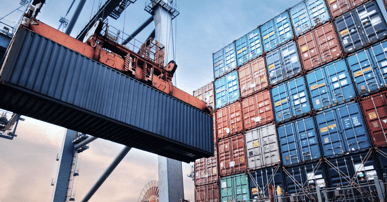The trade war, COVID restrictions, the invasion of Ukraine, and a range of other factors have all increased the focus on supply chain security in recent years.
Nearshoring and onshoring have long been talked about, revolving around a strategy of moving at least a part of production closer to consumer markets. This typically includes a focus on Central and South America for the US, and Eastern Europe or North Africa for the European Union.
However, increased geopolitical tensions have raised awareness of just how quickly everyday operations can be disrupted. This is when “friendshoring” comes into play. Most recently Janet Yellen, the US Treasury Secretary has underlined the need for the United States to secure its supply chains through friendshoring.
Mounting tensions
Friendshoring involves moving investment and production to countries considered allies (or “friends”). This aims to avoid the kind of trade disruptions experienced when Russia invaded Ukraine, leading to a slew of international sanctions.
In a changing geopolitical climate, China has become a natural focal point.
Concern is growing that the trade war acted as a starting gun for deteriorating relationships with the West, in particular the US, and that those tensions are now escalating thanks to the ‘Taiwan question’.
Over the last few weeks, we have analyzed container rate trends in the Far East and Southeast Asia regions to help shippers anticipate the impact of manufacturing changes.
- Southeast Asia to China trade becomes cheapest as Intra-Asia long-term rates spread widens
- US West Coast bound shipping rates drop faster from Far East than South East Asia
- Long-Term Contract Pricing Spread in Key Asian Trade Lanes to Europe Reemerges
This blog investigates how these growing geopolitical divisions are manifesting in a shift away from manufacturing in China, and an increase in friendshoring.
What does the data show?
Although containerized imports from the Far East to the US were 26% higher in 2022 than in 2017 – the last full year before the trade war started – an evolution in the balance of trade is clear.
Across the five-year period, China ties with Singapore for the lowest growth in imports, at ‘just’ 7.0% (all 12 of the major economies in the region, except for Hong Kong, increased containerized exports to the US). In percentage terms, ‘friendly’ Vietnam was the clear winner, with a growth rate of 156%. However, it’s worth noting that when measured in tonnes China comes only second to Vietnam in extra export volume.
Of the total containerized goods being imported by the US from the Far East, 56% came from China in 2022, down 10 percentage points from 2017. The biggest winner of this shift is, again, Vietnam, which has seen its market share almost double, from 6% in 2017 to 11% in 2022.
In the first two months of 2023, US imports from the Far East fell by 15.3% year-on-year. Only two Far Eastern countries were able to grow their exports to the US during this period - Cambodia (+20.1%) and Singapore (+21.6%). Other South East Asian countries were still able to grow their market share, as the biggest losses came from China, Hong Kong and Taiwan. Containerized imports from Thailand and Vietnam also fell, by 4.1% and 3.2% respectively.
Export data from March and April demonstrate the clear drop in exports from China to the US, with March’s figures USD 3.6 billion lower than the year before. However, despite this significant fall, China’s total exports managed an impressive year-on-year growth rate of 15% in March.
How? Russia is the obvious answer.
To Russia with love
Hit by sanction restrictions elsewhere, Russia boosted its exports from China by USD 5.2 billion year-on-year, more than making up for the US shortfall. Exports to South Asian countries also posted strong year-on-year growth for the month.
In contrast to the US, Europe has maintained its share of total imports from China. Of exports coming from the Far East, 55.2% originated from China in both 2022 and in the first two months of 2023. This shows a different approach from that taken by the US – an observation backed up by the fact that the leaders of the two largest European economies visited China in the last six months.
Nevertheless, the European Commission appears to be hardening its stance, going as far as to suggest the cancellation of a trade deal it reached with China in 2020, as part of what they see as a de-risking process.
Today’s investments, tomorrow’s trends
Customs data shows what has already happened, but friendshoring can take time to ‘come online’, as new factories and production centres need to be established. Flows of foreign direct investment (FDI) can give clues to future trading patterns, revealing where investments are being made today for tomorrow.
The International Monetary Fund (IMF) has recently published an analysis of FDI flows, showing how these are changing and shifting. On a global level, foreign direct investments have slowed down in recent years, falling to 1.3% of GDP between 2018 and 2022, compared to 3.3% in the 2000s.
Apart from the overall slowdown, the report highlights the increasing share of FDIs streaming to countries that share geopolitical values with investor nations. This appears to be playing a greater role in investment decisions than geographical proximity.
Investments by foreign companies into China fell to their lowest level in close to two decades in the second half of 2022, collapsing by 73% year-on-year, down to USD 42.5 billion. Putting this into context, between the second half of 2020 and first half of 2022, foreign investments averaged USD 160 billion in each half year.
IMF data shows that FDI flows both into and out of China have fallen faster than the global decline in FDIs.
In contrast to the falling investment into China, Vietnam has seen FDIs grow by 61.2% year-on-year across the first three months of 2023. This example of “friendshoring in action” included a 62.1% increase in the number of new foreign-invested projects. The sector attracting the most foreign capital is, perhaps as expected, the processing and manufacturing sector, accounting for around 75% of the total.
Is shipping ready?
As seen in the customs data, exports from South East Asia are already increasing, with more to come as the new projects start producing.
However, infrastructure in the region is not yet sufficient to allow it to fully compete with China. The latter has made huge investments in its port infrastructure, with around twice as many ports catering for 14 000 TEU+ container ships than in the rest of South East Asia combined. Four of the five biggest container ports in the world are now located in China.
But, change is taking place. Investments are now being made around the region, funded both by state, private and foreign investors. For example, MSC has expressed interest in partnering with Vietnam Maritime Corporation to build a container port with a capacity of 15 million TEU, capable of receiving the world’s biggest ships. Vietnam will undertake a wider USD 13 billion port infrastructure project by 2030.
Elsewhere, construction on a new USD 1.5 billion port project in Cambodia is being funded by Chinese investors as part of the Belt and Road initiative. In addition, the largest port in the region, Singapore, is investing in upgrading its facilities, building the new Tuas mega port, which, once completed, will be capable of handling 65 million TEU per annum.
Once developed, these new ports will allow bigger ships to call, reducing the need for feeders and transhipments, thus improving transit times, while still offering economies of scale.
Friendshoring, it appears, is more than just a buzzword – it’s a phenomenon that could redress the balance of world trade.
Not only does being informed and proactive allow individuals and businesses to adapt to changing circumstances, but it also provides them with opportunities to take advantage of emerging markets and innovative trade practices. Keeping a pulse on the latest developments and trends in global trade can make all the difference in achieving success.
Market transparency is a must-have
Are you looking for visibility into the volatile container shipping market? Find out how simple it is to get the insights and intelligence you need to make sure you, your team and your business quickly adapt to changing market conditions.
Know instantly how your air and ocean freight rates compare against the market, justify your transportation costs, prepare for your tender period and report on your success with one powerful easy-to-use platform. Get a demo now!
%201.png)




